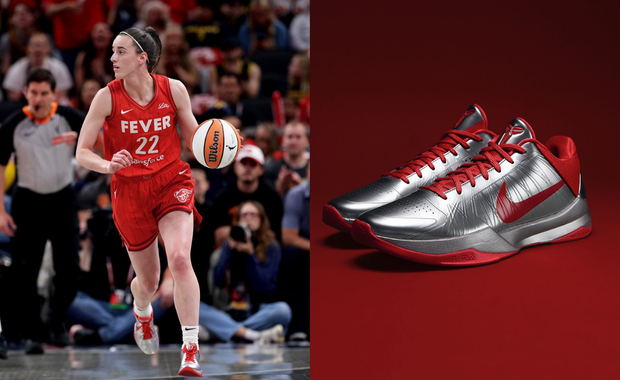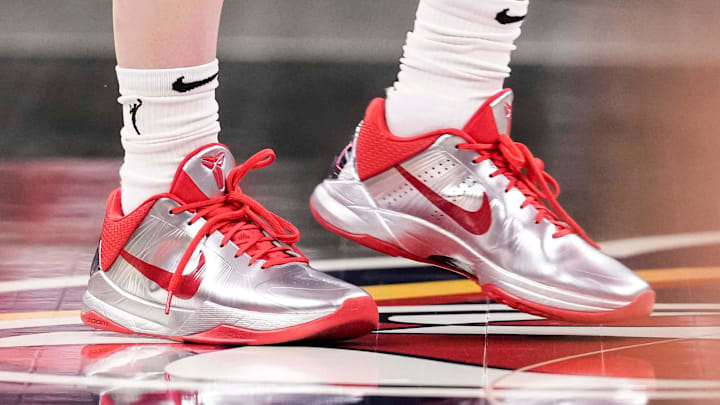For most athletes, particularly women in basketball, earning a shoe deal is already a monumental achievement, often arriving only after championship wins or a legacy of dominance, yet for Clark, this recognition has come during the earliest phase of her professional career, signaling that Nike sees her as more than just a star, but as a movement in motion.
The announcement is not just about footwear or fashion, but about cultural power, because by elevating Clark with a dedicated line, Nike is declaring that women’s basketball has entered a new era where its brightest talents are not confined to the margins, but instead celebrated as global trendsetters with influence far beyond the hardwood.

Caitlin Clark’s rise has always been about more than points scored or records broken, because her ability to capture attention has made her both a basketball prodigy and a cultural lightning rod, and Nike’s investment confirms what fans already know: that she embodies both the competitiveness of an athlete and the charisma of an icon.
This moment is particularly powerful because it collapses the traditional timeline of stardom, as Clark is not waiting until the twilight of her career to become a legend in the marketplace, but instead stepping into her prime years with the full force of a brand that has built its empire by aligning with sports immortals.
By unveiling her own logo, Nike is giving Clark a visual identity that can travel as quickly as her highlight reels, turning every step on the court into a fashion statement, and every fan purchase into a declaration that the future of the game, and of sports fashion, belongs to her.
Her first signature shoe will carry more than performance technology—it will also carry symbolism, because it represents the intersection of gender equity, athletic brilliance, and cultural resonance, proving that women athletes are not simply endorsements but visionaries whose influence can shape design, inspire communities, and redefine what the marketplace expects.
For women’s basketball, this partnership serves as a watershed moment, because while legends like Sheryl Swoopes, Lisa Leslie, and Diana Taurasi opened doors in their own ways, Clark’s Nike deal comes at a time when the global market is more connected than ever, ensuring her influence stretches far beyond American audiences.
The apparel line, scheduled for 2026, is more than just merchandise—it is a cultural toolkit, allowing fans to wear the identity of resilience, excellence, and innovation that Clark represents, and in doing so, Nike is crafting a community of supporters who see themselves not just as consumers but as participants in her journey.
What separates Clark from many others is the authenticity she brings, because while some athletes struggle to balance their competitive fire with commercial expectations, Clark has always thrived in the spotlight, turning pressure into performance, and that same magnetism now becomes the foundation of Nike’s newest global narrative.

It is worth noting that this announcement is also a business decision with competitive undertones, because Nike is not simply rewarding Clark’s accomplishments, but also staking a claim in the cultural battlefield, declaring that the future of women’s basketball—and perhaps the future of global sports marketing—will carry the swoosh on Clark’s shoulders.
In many ways, this partnership can be read as a declaration of war, not in the literal sense, but in the symbolic realm of influence, because Nike has made it clear that other brands will be fighting to keep up, and that Clark’s star power will dictate trends rather than chase them.
For Caitlin Clark herself, this is validation of years of hard work, from high school gyms to sold-out college arenas, where she honed not just her game but her identity as a competitor who thrives under pressure, and now she enters the professional stage with a brand ready to amplify her story worldwide.
What is striking about Clark’s journey is how seamlessly basketball and fashion intertwine in her persona, because while her dominance on the court demands respect, her ability to connect with younger generations, embrace individuality, and redefine what a star looks like has made her the perfect ambassador for Nike’s evolving vision.
Every major shoe release has carried with it cultural echoes, whether it was Michael Jordan’s Air Jordans redefining sneaker culture, or Kobe Bryant’s lightweight innovations reshaping performance footwear, and Clark’s signature line has the potential to do the same for women, empowering them to see themselves as central, not peripheral, to basketball’s global story.
The early unveiling of her logo speaks volumes, because it is not merely a graphic but a symbol of continuity, allowing fans to rally behind something that is both tangible and aspirational, a reminder that Clark’s presence will echo not just in arenas but in everyday culture, from classrooms to streetwear.

Nike’s decision to go all-in on Caitlin Clark is also reflective of broader social changes, as conversations about equality, representation, and visibility in sports have reached new heights, and Clark’s ascent demonstrates that progress is not only happening but accelerating, with brands choosing to lead rather than follow.
While some may see this as a commercial transaction, those who understand the dynamics of influence recognize that it is also a cultural reordering, because Clark’s brand is now intertwined with Nike’s global platform, ensuring her voice and her image will become part of a narrative that reaches millions, if not billions, of people.
As 2026 approaches, anticipation will only grow, because every glimpse of her signature shoe, every leak of apparel design, and every promotional campaign will become part of the myth-making process, elevating Caitlin Clark from star athlete into cultural phenomenon, a bridge between basketball’s heritage and its future.
Ultimately, what Caitlin Clark and Nike have achieved together is not simply the signing of a deal, but the creation of a movement, one that tells young athletes everywhere that stardom is not bound by tradition, that fashion and basketball are not separate lanes, and that when greatness appears early, it deserves to be celebrated globally.